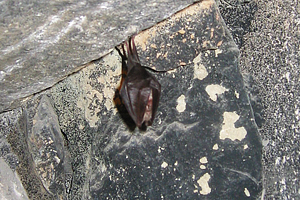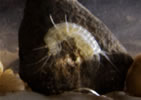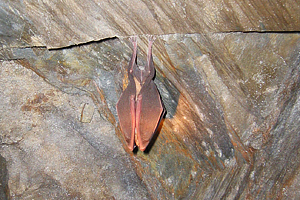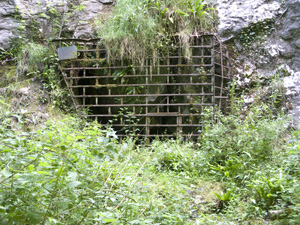Bats are the only other mammal many people will see in a cave.
During summer bats move around and have a selection of roosting sites, often old trees, buildings etc. They may use caves to roost during this time and the females may use them as a nursery for the young. If food is scarce they sometimes go into torpor (controlled lowering of body temperature) much like a hibernating bat. An active bat will have a temperature of about 39 degrees and a heart beat of 1000 per minute. Bats live up to 15 years, they generally eat large insects.
HIBERNATING BATS
Bats spend more time in torpor as food becomes scarce. They traditionally hibernate from October to late April as their food source (insects) disappears, but with warmer winters more insects are around and the hibernation period is becoming more irregular. In late autumn they put on weight (not by eating more but by spending more time in torpor) so that their fat reserves will last them for up to five months of hibernation. Once a suitable hibernation site has been found (the air flow, humidity and temperature must be fairly constant – cooler than their summer roosting sites) they crawl into a crevice (only some species hang upside down). In caves they may be far underground where temperature varies little, but in a position where they are able to sense subtle changes in air temperature signifying changes outside. Heavy bats prefer warm roosts, skinny bats cooler roosts. Old wise bats regulate their temperature within a narrower band than youngsters and seem to roost singly.
In hibernation a bat may breathe once an hour, have a temperature as low as 2C, and a pulse of 10 per minute. Reducing its temperature means it uses less energy.
By November they may only wake when it is warmer and they can feed. Each day throughout hibernation the bats pulse rate slowly rises until it seems to make an unconscious decision (in mid afternoon) either to carry on raising its pulse and wake up, or allow it to drop again and return to hibernation. Every 10-15 days throughout winter they will wake to feed, urinate, just shuffle their feet, drink or fly off to roost somewhere else (up to 30 miles away). As winter moves by the bats fat reserves dwindle and they choose progressively colder roosts. In November they may go for a 12C roost, by March they prefer a 6C roost. In April they spend less time asleep and choose cool roosts close to feeding grounds, after digestion the bat allows its temperature to drop quickly.
If they are disturbed, they slowly wake up – 30 minutes after disturbance the heart rate will have gone from about 20 to 600 beats per minute and the body temperature from about 10C to 36C. This must use a surprising amount of energy, energy the bat cannot afford to use up unnecessarily as the valuable fat reserves are depleted with little hope of replenishment. Too many disturbances will mean that the fat reserves will not last the winter and they literally starve to death. In a state of hibernation bats are so torpid that they appear dead, but it takes very little to disturb them. Bats are quite specific on what temperature they want to hibernate at. Heat from cavers bodies will cause a rise in temperature which is detected by the bat. In a large or draughty passage this effect will be negligible, but in a small chamber or with a group of cavers the effect may be enough to rouse the bat. Heat generated by a caver is probably the most common cause of bat disturbance underground. Shining bright lights on the bat and the noise of a flashgun may be sufficient to wake it up.
Many bats in Britain are on the northern limit of their distribution - a small climate change could have major impacts.
All 16 species of British bat can be found in Devon, with different species using caves to varying degrees.
The HORSESHOE BATS have a cone shaped nose leaf and hang by their hind feet with their wings wrapped around themselves. In Devon they are the most commonly noted bats in caves. The Lesser Horseshoe bat (Rhinolophus hiposidero) is 15-19mm in length and weighs just 5-9 grams, making it one of our smallest bats. In winter their roost in the cave is usually in open or exposed positions, and not in clusters. They prefer cooler sites than the Greater Horseshoe and can often be seen sharing the same winter roosts but in more exposed parts of the cave ceiling. They are small and very agile and can be found deep underground. The coolest sites in a cave are near the floor so these bats may be found low down on boulders near your feet as well as hanging on the walls and ceiling. Following a decline in the last 100 years the population of lesser horseshoes now appears to be stable.

Lesser horseshoe bat |
|
In summer they emerge from their roost 30 minutes after sunset to feed in sheltered deciduous woodland.
The Greater Horseshoe bat (Rhinolophus ferrum-equinum) prefers warm roosts. Their summer nursery roosts include a few caves where they congregate, tightly packed, in high domed chambers to raise the temperature to 30C, but this is increasingly rare in Britain. In autumn, as the nursery breaks up, the adults seek out cooler areas while the young may stay until October. Males may roost underground in summer. It prefers temperatures of 5-11C and it is quite common for it to wake and feed on warmer winter evenings. Devon has the largest population in Britain and includes the only site with a population in excess of 1000. Several caves and mines around the Buckfastleigh area are protected as important horseshoe roosts, including the Rock House Quarry caves, Rift and Reed’s caves in Higher Kiln Quarry and Bulkamore Iron Mine, as well as Haytor Mine on Dartmoor and Pixies’ Hole near Chudleigh. The British population is estimated at 4000, with Devon being an important stronghold for the species, - its numbers have declined massively and it could be vulnerable to extinction in Britain.
The Evening or VESPER BATS are a family that includes Pipestrelles, these have a muzzle similar to a dog and prefer to hang against a surface like a wall or tree. These bats fold their wings alongside their bodies. If you see a small bat flying outside before dark it is probably a Pipestrelle.
Pipestrelles (Pipestrellus spp.) are Britain’s most common bats but are rarely found in caves.
Barbestrelle (Barbestrella barbastellus) - rarely seen, it uses caves for hibernation.
Brown Long Eared bats (Plecotus auritus) hunt in dense vegetation. This bat and the Barbestrelle prefer cold caves to hibernate – down to 0C. This means they are more likely to be found hibernating near the entrances to caves. Grey Long Eared bat (Plecotus austriacus) – a rare species on the northern edge of its distribution in Britain. The estimated 1000 in Britain are found along the south coast of Britain, generally prefers trees and buildings in which to roost. Like the Brown Long Eared it is very tolerant of the cold.
Noctule (Nyctalus noctula) – Britain’s largest bat, if you see a large bat flying in the open out before dark it is probably a Noctule. They roost almost exclusively in tree holes in the UK but occasionally enter caves in autumn.
Leisler’s bat (Nyctalus leisleri) generally prefers holes in trees and buildings and does not often frequent caves.
The Serotine (Eptesicus serotinus) is a large bat, which generally inhabits buildings and hollow tress but which has been recorded as hibernating in caves and mines.
MYOTIS BATS prefer 2-5C. They may be seen swarming round cave entrances in autumn. Many Myotis bats hibernate in crevices including wriggling into loose scree/boulders – so a bat motionless by your feet might be hibernating, not dead! Natterer's bats (Myotis nattereri) hibernate almost exclusively in caves and mines, usually squeezed in a crack or crevice. They hunt in dense vegetation. Daubenton's bat (Myotis daubentoni) hibernates in caves, mines, tunnels in crevices as well as on open walls. They hunt low over open water and so are found near such habitats. Whiskered bats (Myotis mystacinus) hibernate singly in caves on open walls and in crevices. Brandt's bat (Myotis brandti) appears to have similar habits to the Whiskered bat. The rare Bechstein’s bat (Myotis bechsteini) was first recorded in Devon in 1966 and the species can be found in Berry Quarry and caves. The Alcathoe bat has recently been confirmed as living in the UK. It is very similar to Brandt's and Whiskered and so presumably can be found in caves.
Bat guano is important in the cave ecosystem. Bats eat half their weight in insects each day producing large amounts of nitrogen rich guano. This guano is food for beetles and other forms of cave life. Bats often carry parasites such as ticks, fleas and mites.
BATS AND THE LAW
It is illegal to intentionally or recklessly disturb a bat while it is occupying a structure or place that it uses for shelter or protection. Under the Habitats Regulations it is an offence to deliberately disturb a bat (this applies anywhere, not just at its roost). If more than one bat is involved, the fine is £5,000 per bat.
Bat workers acknowledge the important help they get from cavers to know what is going on in the roosts and hibernaculums used by bats that are inaccessible to non-cavers. Cavers can assist bat conservation groups by not disturbing the bats and by reporting their findings. See the Bat Conservation Trust for more information on bats.
OTHER MAMMALS
You may see evidence of badgers, foxes, otters, mink or rats using a cave entrance for shelter.
|
Vole skeleton, Corbridge Cavern |
|
Bat friendly grill on Rift Cave |
|




.jpg)
